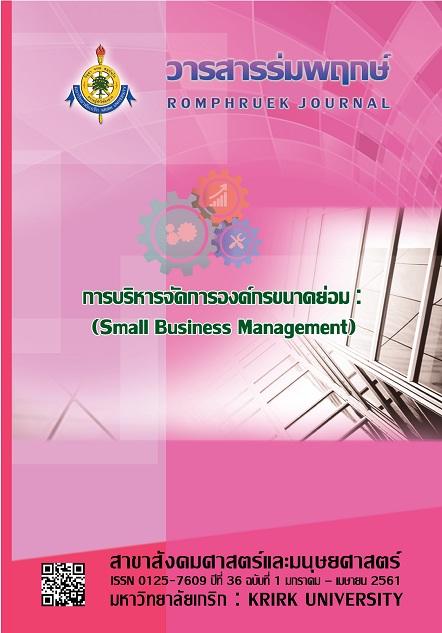Supply Chain Analysis of Small Organic Rice Mills in Chiang Mai Province Using Supply Chain Operations Reference (SCOR) Model
Main Article Content
Abstract
This research aimed at analyzing the supply chain of small organic rice mills based on Supply Chain Operations Reference (SCOR) model. The data were collected from population in Chiang Mai Province by using snowball sampling technique and applying in-depth interview of stakeholders from upstream to downstream. The results showed that supply chain of small organic rice mills should improve main processes, that is, Supply Chain Plan (sP1), Source Make-to-Order Product (sS2), Deliver Stocked Product (sD1), and Make-to-Stock (sM1). With regard to enable processes, an improvement should focus on Manage Plan Inventory Performance (EP.2), Source Assess Performance (ES.2), Source Manage Transportation (ES.6), and Make Assess Performance (EM.2). The findings revealed some guidelines for key activities to improve efficiency along the supply chain of small organic rice mills.
Article Details
Every article published in the Romphruek Journal of the Humanities and Social Sciences is the opinion and point of view of the authors. Thery're not the viewpoint of Krirk University or the editored department. Any part or all of the articles for pablication must be clearly cited.
References
กระทรวงพาณิชย์. (2560). สินค้าออกสำคัญ 10 อันดับแรก. (20 กรกฎาคม 2560) สืบค้นจาก http://www2.ops3.moc.go.th.
ทำนอง ชิดชอบ. (2554). การพัฒนารูปแบบการมีส่วนร่วมในการจัดการห่วงโซ่อุปทานข้าวหอมมะลิเกษตรอินทรีย์เพื่อการส่งออกของสหกรณ์เกษตรอินทรีย์ บ้านตระแสง อำเภอเมือง จังหวัดสุรินทร์. วารสารราชภัฏเพชรบูรณ์สาร, 13(2), 1-8.
ปราโมทย์ ยอดแก้ว. (2560). การพัฒนาการตลาดข้าวอินทรีย์ในสังคมไทย. วารสารสันติศึกษาปริทรรศน์, 5(1), 406-420.
ปรีชา ปิยจันทร์ นุชนาท จันทเตมีย์ เจริญ สุธรรมชัย ณัฐถะปราน คล้ายประสิทธิ์ และกนกนาถ รัตนานุพงศ. (2552). การปลูกผลไม้เกษตรอินทรีย์ปัญหาและอุปสรรค กรณีศึกษาในเขตพื้นที่จังหวัดระยอง จันทบุรี และตราด. วารสารร่มพฤกษ์, 27(2), 135-185.
ผดุงศักดิ์ วานิชชัง ใจทิพย์ วานิชชัง และ สมควร มณีพิทักษ์สันติ. (2557). การปรับปรุงผลิตภาพการดำเนินงานโรงสีข้าวสหกรณ์. การนำเสนอผลงานวิชาการ มทร.ตะวันออก มรภ.กลุ่มศรีอยุธยาและราชนครินทร์วิชาการและวิจัย ครั้งที่ 7 วันที่ 14-16 พฤษภาคม 2557 ณ มหาวิทยาลัยเทคโนโลยีราชมงคลตะวันออก ชลบุรี.
วิวัฒน์ ไม้แก่นสาร และ มลฤดี จันทรัตน์. (2558). การดำเนินงานและปัญหาของโรงสีข้าวชุมชนในภาคตะวันออกเฉียงเหนือ.
วารสารปัญญาภิวัฒน์, 7(2), 17-27.
สมาคมผู้ส่งออกข้าวไทย. (2560). ผลผลิตข้าว. (20 ตุลาคม 2560) สืบค้นจาก www.thairiceexporters.or.th
สนั่น เถาชารี และ ระพีพันธ์ ปิตาคะโส. (2555). การจัดการโลจิสติกส์และโซ่อุปทานข้าวในภาคตะวันออกเฉียงเหนือของประเทศไทย. วารสารวิจัย มข, 17(1), 125-141.
สัญชัย ลั้งแท้กุล และ เจษฎา นกน้อย. (2559). รูปแบบโซ่อุปทานและประสิทธิภาพการจัดการโซ่อุปทานและโลจิสติกส์อุตสาหกรรมการผลิตข้าวสังข์หยดเมืองพัทลุง : ระดับขั้นเกษตรกรและกลุ่มวิสาหกิจแปรรูป. วารสารการพัฒนาชุมชนและคุณภาพชีวิต, 4(1), 32-44.
สำนักงานคณะกรรมการพัฒนาการเศรษฐกิจและสังคมแห่งชาติ. (2559). แผนพัฒนาเศรษฐกิจและสังคมแห่งชาติฉบับที่ 12
(2560-2564). กรุงเทพฯ : สำนักนายกรัฐมนตรี.
อนุรักษ์ ปานสีดำ. (2552). ห่วงโซ่คุณค่าการเกษตรที่สนับสนุนโดยชุมชน กรณีศึกษา : กลุ่มเกษตรกร “โครงการผักประสานใจ”
อำเภอด่านช้าง จังหวัดสุพรรณบุรี. วารสารร่มพฤกษ์, 27(1), 161-180.
Bátori, Z. (2010). Supply chain intelligence: Benefits, Techniques and Future trends. Proceedings of the 8th International Conference on Management, Enterprise and Benchmarking Óbuda University, Budapest Hungary. 233-240.
Chaffey, D. (2007). E-business and E-commerce Management : Strategy, Implementation and Practice. London, UK : Pearson Education, Inc.
Christopher, M. (1999). Logistics and Supply Chain Management: Strategies for Reducing Cost and Improving Service. London, UK : Financial Times/Pitman.
Handfield, R. B., & Nichols, E. L. (2002). Supply chain redesign : Transforming supply chains into integrated value systems. London, UK : Financial Times/Pitman.
Kamble, S., Desai, A., & Vartak, P. (2015). Data mining and data warehousing for supply chain management. Proceedings of Conference on Communication, Information & Computing Technology Mumbai Mumbai University, India. 1-6.
Mahanaseth, I., & Tauer, L. W. (2014). Thailand’s market power in its rice export markets. Journal of agricultural & food industrial organization, 12(1), 109-120.
Husby,P. (2007). Know the Score : The strengths and limitations of the Supply Chain Operations Reference (SCOR) model. (December 4, 2017) Retrieved from http://www.mhlnews.com/facilities-management/know-score.
Seifbarghy, M., Akbari, M. R., & Sajadieh, M. S. (2010). Analyzing the supply chain using SCOR model in a steel producing company. Journal of Japan Industrial Management Association, 62(6), 1-6.
Sellitto, M. A., Pereira, G. M., Borchardt, M., da Silva, R. I., & Viegas, C. V. (2015). A SCOR-based model for supply chain performance measurement : Application in the footwear industry. International Journal of Production Research, 53(16), 4917-4926.
Stephens, S. (2001). Supply chain operations reference model version 5.0 : a new tool to improve supply chain efficiency and achieve best practice. Information Systems Frontiers, 3(4), 471-476.
SCC. (2017). Supply Chain Operation Reference Model : SCOR Version 12.0. Pittsburgh,
PA : Supply Chain Council, Inc.
Sutopo, W., Maryanie, D.I., & Yuniaristanto. (2015). Evaluation of valuable chain in palm oil industry based on SCOR model : A case study. Journal of Logistics Systems and Management, 21(2), 229-241.
Thunberg, M., & Persson, F. (2014). Using the SCOR model’s performance measurements to improve construction logistics. Production Planning & Control, 25(13-14), 1065-1078.
Yongan, Z., & Menghan, L. (2011). Research on Green Supply Chain design for automotive industry based on Green SCOR Model. Proceedings of International Conference on on Information Management, Innovation Management and Industrial Engineering Shenzhen, China, 549-552.


